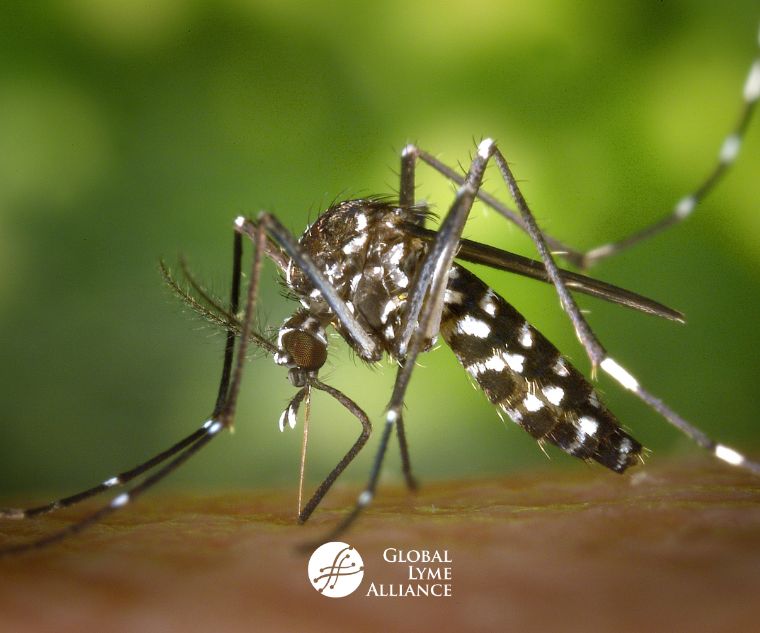
Lyme disease transmission in regard to mosquito bites.
When participating in outdoor activities during warmer weather, we find ourselves shooing off mosquitos and worrying about ticks. Many people wonder, can you get Lyme disease from a mosquito? The short answer is no. Both mosquitoes and ticks are vectors, meaning they can cause diseases in humans and animals through their bites; these are called vector-borne diseases. But each vector carries its own disease-causing microbes. Mosquitos carry mosquito-borne pathogens, and ticks carry tick-borne pathogens. Both vectors can transmit a diversity of viruses, parasites, and bacteria. Let’s walk through the differences between mosquito and ticks-borne diseases and talk about why it’s important to take preventative measures against being bitten by either.
Understanding Lyme Disease
Lyme disease is a bacterial infection spread through the bite of an infected black-legged tick, sometimes called a deer tick (its scientific name is Ixodes scapularis in the Eastern United States, and Ixodes pacificus on the West coast). Black-legged ticks go through four stages in their two-year life cycle: egg, larvae, nymph, and adult. Nymphal ticks and adult female black-legged ticks can transmit Borrelia burgdorferi, the bacteria that causes Lyme disease, to a human or animal. When a black-legged tick bites one of these hosts, it latches on for a few days to have a blood meal. During this time, it can transmit Borrelia burgdorferi and/or pathogens that cause other tick-borne diseases to the host.
Tick populations are growing and moving. Infected black-legged ticks are found throughout the United States and abroad. In the United States, they are most prevalent along the East coast, the West coast, and the Upper Midwest. Ticks like to live in moist, shady places and can be found in any wooded area, as well as in leaf litter, wood piles, tall grass, beach dunes, stone walls, bushy areas, and perimeters where the lawn meets the woods. If you spend time outdoors, you are at risk for Lyme disease. And even if you aren’t in an area where black-legged ticks are endemic, you should be on the lookout for other types of ticks such as the Lone Star tick (Amblyomma americanum), which can transmit diseases such as Heartland virus, and the American Dog Tick (Dermacentor variabilis), which can transmit Rocky Mountain Spotted Fever and tularemia.
In its early stages, Lyme disease can cause an erythema migrans rash as well as flu-like symptoms such as fever, chills, fatigue, joint pain, aches, and swollen lymph nodes. Because ticks are very small and hard to detect, Lyme disease tests are indirect, and not everyone gets a “tell-tale” rash, many Lyme disease cases are not diagnosed or treated until later stages of the disease, which can cause severe illness. In these stages, the Lyme bacteria moves to other parts of the body such as the heart, nervous system, and joints. Symptoms range from stiff neck, to Lyme carditis, to Lyme arthritis, to facial palsy, to brain fog (sometimes referred to as “Lyme brain”).
Mosquitoes as Disease Vectors
While mosquitoes don’t transmit Lyme bacteria, they can transmit Zika virus, West Nile virus, Chikungunya virus, yellow fever virus, dengue virus, and malaria parasites. Different mosquito species in various areas of the world cause different diseases. According to the CDC website on mosquito-borne diseases, not everyone becomes sick after a mosquito bite, but “some people have a mild, short-term illness or (rarely) severe or long-term illness.” In some cases West Nile virus can cause death in children, the elderly, and imunocompromised people.
Scientific Research and Results
According to the CDC, Lyme disease cannot be spread by mosquitoes; it can only be spread through the bite of an infected black-legged tick. Although Lyme disease bacteria have been found in the salivary glands of mosquitoes, there is no evidence that mosquitoes are capable of passing those bacteria to a human or animal because a mosquito bite is too short. Ticks need to be attached for some hours to days to successfully transmit Lyme bacteria and establish infection during a blood meal.
Lyme Disease Prevention Strategies
Some preventative measures for mosquito bites also protect you from tick bites but it is important to account for both when spending time outdoors, since both can spread dangerous illnesses.
Insect repellent can help protect you from both mosquito and tick bites. To repel ticks specifically, use an EPA-approved product with active ingredient DEET or picaridin. Being Tick AWARE is the best method of Lyme disease control. In addition to using repellent, other ways to prevent tick bites include:
- Wear protective clothing such as long-sleeved shirts, long pants, a hat, and closed-toe shoes.
- Wear light-colored clothing to make it easier to spot ticks.
- Use tick repellents on exposed skin, and insecticide like permethrin on clothing and outdoor gear.
- Conduct regular tick checks on yourself and your pets, and remove any attached ticks.
- Inspect bedding and living area for ticks.
- Maintain a well-manicured yard, mow the grass, and remove leaf litter and low brush.
Click below to sign up for GLA's newsletter.
The above material is provided for information purposes only. The material (a) is not nor should be considered, or used as a substitute for, medical advice, diagnosis, or treatment, nor (b) does it necessarily represent endorsement by or an official position of Global Lyme Alliance, Inc. or any of its directors, officers, advisors or volunteers. Advice on the testing, treatment or care of an individual patient should be obtained through consultation with a physician who has examined that patient or is familiar with that patient’s medical history.







-2.jpg)
